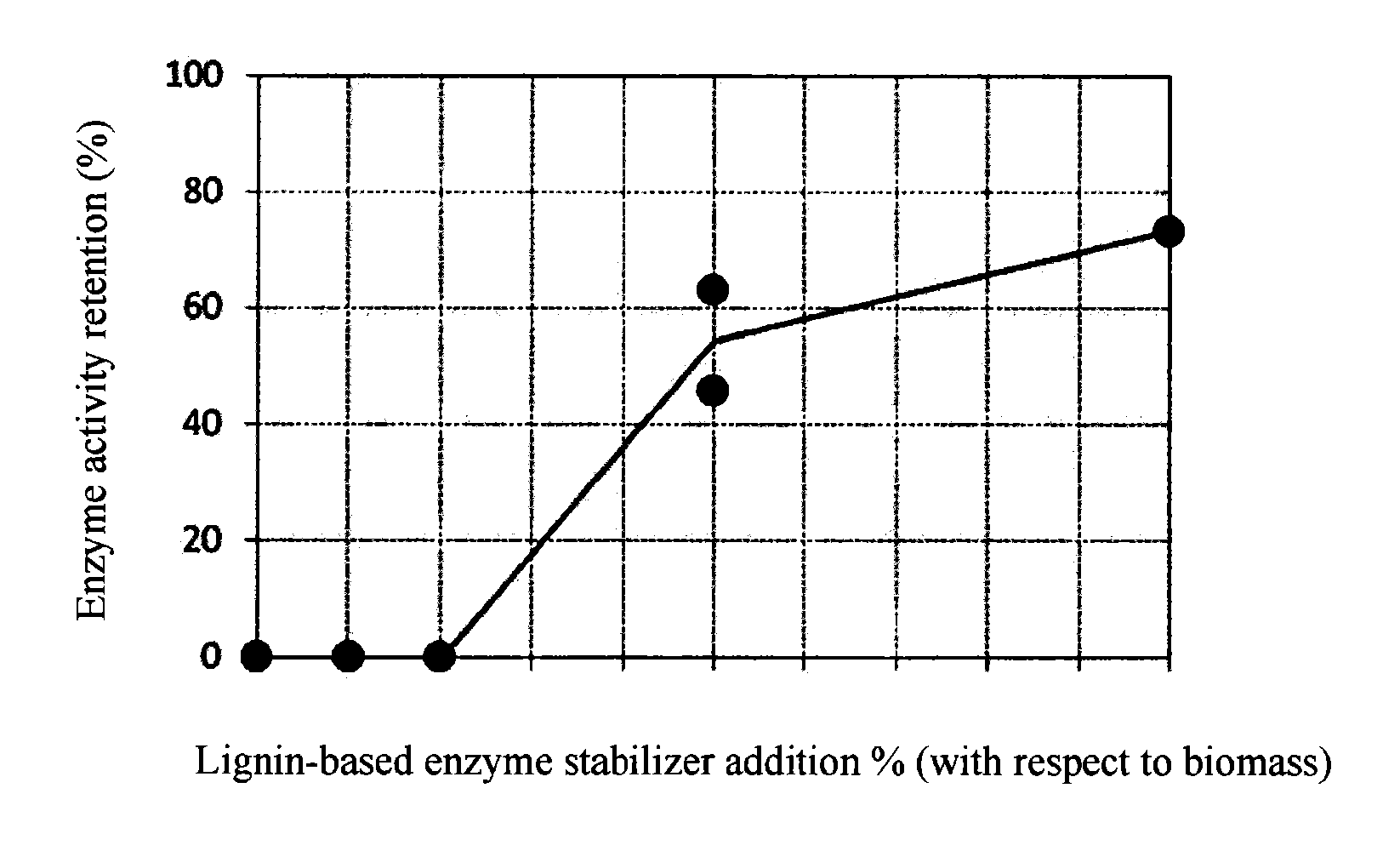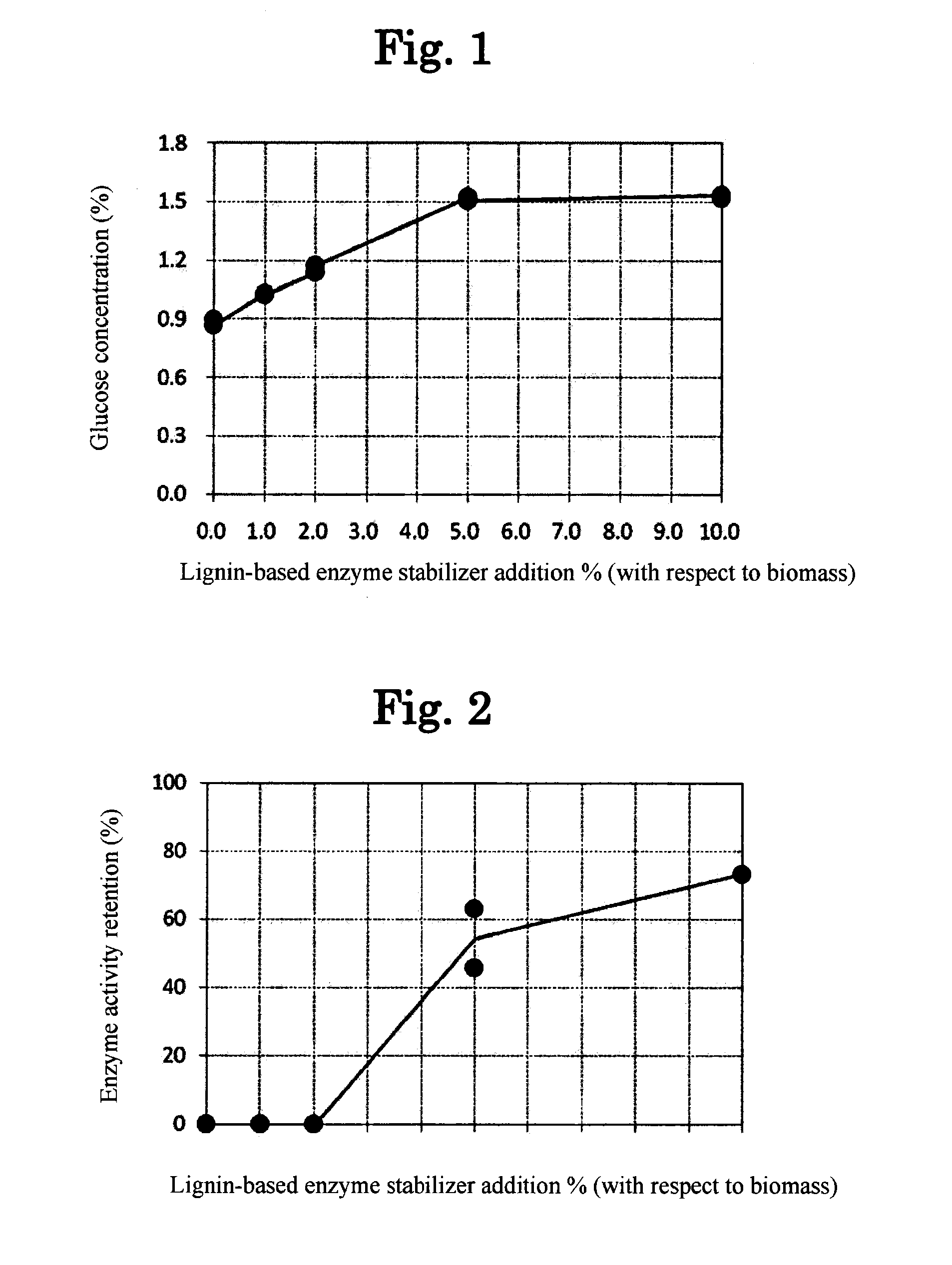Lignin-based enzyme stabilizer
a stabilizer and enzyme technology, applied in the field of lignin-based enzyme stabilizers, can solve the problems of not being widely adopted, and achieve the effects of preventing inactivation of enzymes, reusing enzymes, and inhibiting adsorption of enzymes
- Summary
- Abstract
- Description
- Claims
- Application Information
AI Technical Summary
Benefits of technology
Problems solved by technology
Method used
Image
Examples
embodiment 1
lizer
[0021]The enzyme stabilizer of this embodiment is an enzyme stabilizer comprising a lignin derivative produced by reaction between lignin and a hydrophilic compound. The examples described below demonstrate that the lignin derivative produced by reaction between lignin and a hydrophilic compound, in reaction between a substrate and an enzyme, can prevent inactivation of the enzyme and stabilize the enzyme activity. The enzyme stabilizer of this embodiment comprising a lignin derivative can therefore prevent inactivation of enzymes and stabilize enzyme activity.
(Lignin)
[0022]The lignin used as the starting material for the lignin derivative of the invention may be any type of lignin, such as kraft lignin, lignin acetate, organosolv lignin, steam explosion lignin or the like, separated from wood chips by pulping, or lignin sulfate, alkaline lignin or the like resulting as a by-product of biomass conversion techniques, but there is no limitation to the above. Lignin from any sourc...
embodiment 2
lizing Method
[0055]The enzyme stabilizing method of this embodiment is a method for stabilizing an enzyme, comprising adding a lignin derivative produced by reaction between lignin and a hydrophilic compound to a reaction system comprising a substrate and an enzyme. The examples described below demonstrate that the lignin derivative produced by reaction between lignin and a hydrophilic compound, in reaction between a substrate and an enzyme, can prevent inactivation of the enzyme and stabilize the enzyme activity. The enzyme stabilizing method of this embodiment, which employs the lignin derivative described above, can prevent inactivation of enzymes and stabilize enzyme activity.
[0056]The lignin derivative used in the enzyme stabilizing method of this embodiment basically has the same construction and effect as the lignin derivative used in the enzyme stabilizer explained in detail for Embodiment 1. Explanation of the aspects similar to Embodiment 1 will therefore be optionally omi...
embodiment 3
arification Method
[0059]The enzyme saccharification method of this embodiment is a method of saccharifying lignocellulosic biomass using an enzyme, comprising adding an enzyme stabilizer according to Embodiment 1. The enzyme stabilizer used for this embodiment can prevent inactivation of the enzyme and stabilize the enzyme activity as mentioned above. In a saccharifying method using the enzyme stabilizer, therefore, it is possible to reutilize the enzyme or reduce the amount of enzyme used.
[0060]The phrase “method of saccharifying lignocellulosic biomass using an enzyme (saccharifying method of lignocellulosic biomass using an enzyme)”, as used herein, refers to any method that accomplishes saccharification of lignocellulosic biomass with an enzyme, and for example, it may refer to the saccharifying method (method for producing ethanol) described in Japanese Unexamined Patent Application Publication No. 2008-92910. The content of Japanese Unexamined Patent Application Publication No...
PUM
| Property | Measurement | Unit |
|---|---|---|
| hydrophilic | aaaaa | aaaaa |
| acid resistance | aaaaa | aaaaa |
| physical | aaaaa | aaaaa |
Abstract
Description
Claims
Application Information
 Login to View More
Login to View More - R&D
- Intellectual Property
- Life Sciences
- Materials
- Tech Scout
- Unparalleled Data Quality
- Higher Quality Content
- 60% Fewer Hallucinations
Browse by: Latest US Patents, China's latest patents, Technical Efficacy Thesaurus, Application Domain, Technology Topic, Popular Technical Reports.
© 2025 PatSnap. All rights reserved.Legal|Privacy policy|Modern Slavery Act Transparency Statement|Sitemap|About US| Contact US: help@patsnap.com


